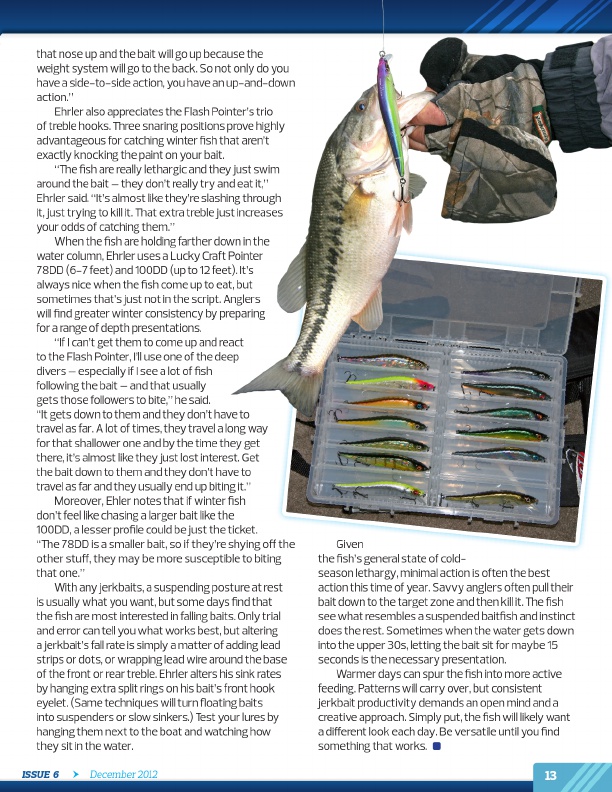
that nose up and the bait will go up because the weight system will go to the back. So not only do you have a side-to-side action, you have an up-and-down action.” ehrler also appreciates the Flash Pointer’s trio of treble hooks. Three snaring positions prove highly advantageous for catching winter fish that aren’t exactly knocking the paint on your bait. “The fish are really lethargic and they just swim around the bait – they don’t really try and eat it,” ehrler said. “it’s almost like they’re slashing through it, just trying to kill it. That extra treble just increases your odds of catching them.” When the fish are holding farther down in the water column, ehrler uses a lucky Craft Pointer 78dd (6-7 feet) and 100dd (up to 12 feet). it’s always nice when the fish come up to eat, but sometimes that’s just not in the script. anglers will find greater winter consistency by preparing for a range of depth presentations. “if i can’t get them to come up and react to the Flash Pointer, i’ll use one of the deep divers – especially if i see a lot of fish following the bait – and that usually gets those followers to bite,” he said. “it gets down to them and they don’t have to travel as far. a lot of times, they travel a long way for that shallower one and by the time they get there, it’s almost like they just lost interest. Get the bait down to them and they don’t have to travel as far and they usually end up biting it.” Moreover, ehler notes that if winter fish don’t feel like chasing a larger bait like the 100dd, a lesser profile could be just the ticket. “The 78dd is a smaller bait, so if they’re shying off the other stuff, they may be more susceptible to biting that one.” With any jerkbaits, a suspending posture at rest is usually what you want, but some days find that the fish are most interested in falling baits. only trial and error can tell you what works best, but altering a jerkbait’s fall rate is simply a matter of adding lead strips or dots, or wrapping lead wire around the base of the front or rear treble. ehrler alters his sink rates by hanging extra split rings on his bait’s front hook eyelet. (Same techniques will turn floating baits into suspenders or slow sinkers.) test your lures by hanging them next to the boat and watching how they sit in the water.
Issue 6
December 2012
Given the fish’s general state of cold- season lethargy, minimal action is often the best action this time of year. Savvy anglers often pull their bait down to the target zone and then kill it. The fish see what resembles a suspended baitfish and instinct does the rest. Sometimes when the water gets down into the upper 30s, letting the bait sit for maybe 15 seconds is the necessary presentation. Warmer days can spur the fish into more active feeding. Patterns will carry over, but consistent jerkbait productivity demands an open mind and a creative approach. Simply put, the fish will likely want a different look each day. Be versatile until you find something that works.
13